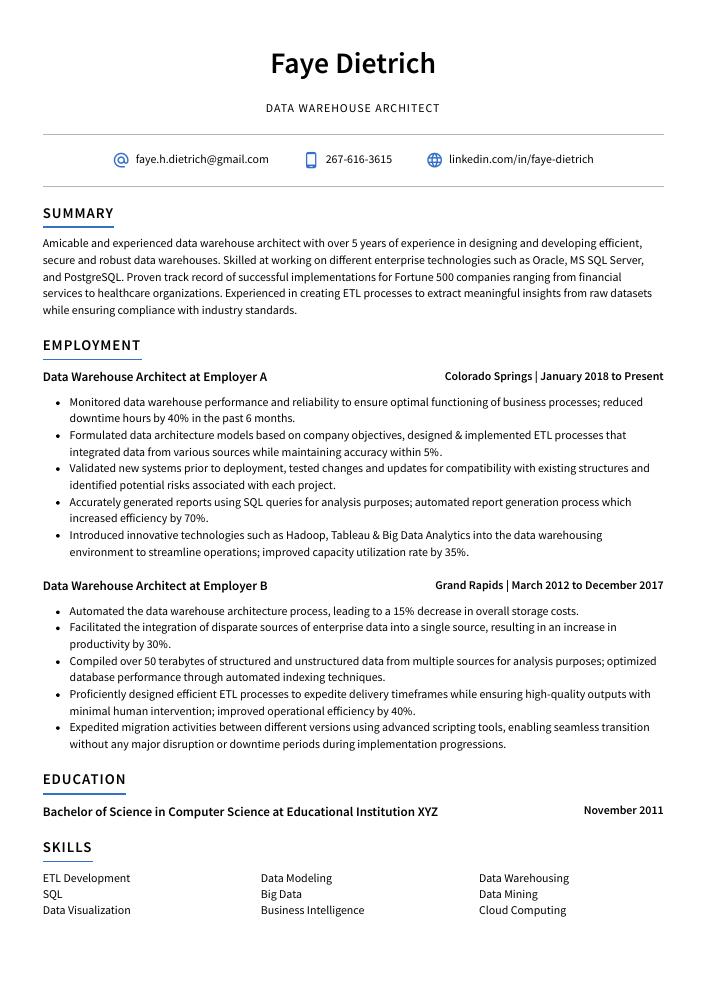Data Warehouse Architect Resume Guide
Data warehouse architects design, build and maintain data warehouses to store large amounts of corporate data for analysis. They use their technical expertise to ensure that the architecture is optimized for performance, scalability and security. Additionally, they are responsible for creating ETL (extract-transform-load) jobs which extract data from various sources into the warehouse as well as designing reports and dashboards so users can visualize insights drawn from the stored data.
Data warehousing is your specialty, and you know how to design databases like the back of your hand. But hiring managers need to be made aware of your expertise, so writing a resume that expresses what an asset you would be is key.
This guide will walk you through the entire process of creating a top-notch resume. We first show you a complete example and then break down what each resume section should look like.
Table of Contents
The guide is divided into sections for your convenience. You can read it from beginning to end or use the table of contents below to jump to a specific part.
Data Warehouse Architect Resume Sample
Faye Dietrich
Data Warehouse Architect
[email protected]
267-616-3615
linkedin.com/in/faye-dietrich
Summary
Amicable and experienced data warehouse architect with over 5 years of experience in designing and developing efficient, secure and robust data warehouses. Skilled at working on different enterprise technologies such as Oracle, MS SQL Server, and PostgreSQL. Proven track record of successful implementations for Fortune 500 companies ranging from financial services to healthcare organizations. Experienced in creating ETL processes to extract meaningful insights from raw datasets while ensuring compliance with industry standards.
Experience
Data Warehouse Architect, Employer A
Colorado Springs, Jan 2018 – Present
- Monitored data warehouse performance and reliability to ensure optimal functioning of business processes; reduced downtime hours by 40% in the past 6 months.
- Formulated data architecture models based on company objectives, designed & implemented ETL processes that integrated data from various sources while maintaining accuracy within 5%.
- Validated new systems prior to deployment, tested changes and updates for compatibility with existing structures and identified potential risks associated with each project.
- Accurately generated reports using SQL queries for analysis purposes; automated report generation process which increased efficiency by 70%.
- Introduced innovative technologies such as Hadoop, Tableau & Big Data Analytics into the data warehousing environment to streamline operations; improved capacity utilization rate by 35%.
Data Warehouse Architect, Employer B
Grand Rapids, Mar 2012 – Dec 2017
- Automated the data warehouse architecture process, leading to a 15% decrease in overall storage costs.
- Facilitated the integration of disparate sources of enterprise data into a single source, resulting in an increase in productivity by 30%.
- Compiled over 50 terabytes of structured and unstructured data from multiple sources for analysis purposes; optimized database performance through automated indexing techniques.
- Proficiently designed efficient ETL processes to expedite delivery timeframes while ensuring high-quality outputs with minimal human intervention; improved operational efficiency by 40%.
- Expedited migration activities between different versions using advanced scripting tools, enabling seamless transition without any major disruption or downtime periods during implementation progressions.
Skills
- ETL Development
- Data Modeling
- Data Warehousing
- SQL
- Big Data
- Data Mining
- Data Visualization
- Business Intelligence
- Cloud Computing
Education
Bachelor of Science in Computer Science
Educational Institution XYZ
Nov 2011
Certifications
Certified Data Warehouse Architect
International Association of Software Architects
May 2017
1. Summary / Objective
Your resume summary/objective should provide the hiring manager with a snapshot of your experience and skills as a data warehouse architect. You can use this section to highlight your technical expertise, such as knowledge of ETL processes, SQL scripting, and cloud computing platforms; any certifications or awards you have received; how many successful projects you have completed in the past; and what makes you stand out from other candidates.
Below are some resume summary examples:
Seasoned data warehouse architect with 8+ years of experience in developing and managing enterprise-level data warehouses. Highly knowledgeable in ETL processes, database design, reporting tools, and business intelligence solutions. At XYZ Corporation implemented a hybrid cloud/on-premise solution for the centralization of their data warehouse architecture which resulted in cost savings of 28%. Skilled at optimizing existing systems to improve performance and scalability while ensuring compliance with regulatory standards.
Determined data warehouse architect with 8+ years of experience in designing and developing business intelligence solutions. Proven track record of successfully managing complex projects, including the design and implementation of an enterprise-level data warehouse for a Fortune 500 company that increased productivity by 25%. Experienced in creating ETL processes to transform raw data into meaningful insights. Skilled at writing SQL queries to extract relevant information from databases.
Passionate data warehouse architect with 10+ years of experience leading the design and implementation of data warehouses. Skilled in utilizing cutting-edge technologies to optimize performance, scalability, security, and reliability. At XYZ Company improved data access time by 25% across multiple sites using innovative architecture solutions. Seeking to join ABC Tech as a Data Warehouse Architect for their global clients.
Diligent data warehouse architect with 10+ years of experience in designing, developing and deploying enterprise-level data warehouses on various platforms. At XYZ, successfully designed a multi-terabyte data warehouse for an international logistics company that achieved cost savings of 20%. Proven track record in creating innovative solutions to increase efficiency across the organization and reduce technical complexity.
Enthusiastic data warehouse architect with 5+ years of experience developing data warehouses from the ground up. Proven track record of deploying high-quality solutions in tight timelines, while ensuring compliance and security requirements were met or exceeded. Seeking to join ABC Tech to utilize my expertise in building data pipelines, ETL processes, and modeling for insightful analyses that drive business decisions.
Well-rounded data warehouse architect with 6+ years of experience designing and developing enterprise data warehouses. At XYZ, designed a highly scalable system that improved latency by 40%. Adept at leveraging cutting-edge technologies such as Hadoop, NoSQL, and Apache Spark to build secure systems for clients in multiple industries. Looking to join ABC Corp to continue my career in building innovative solutions.
Detail-oriented data warehouse architect with 10+ years of experience designing, developing and managing complex data warehouses. Skilled in the use of leading ETL tools such as Informatica and SSIS to deliver quality solutions that meet customer requirements. Looking to join ABC Tech where I can bring my expertise in data integration, warehousing, and analytics projects to help drive greater business success.
Reliable data warehouse architect with 10+ years of experience in designing, building and maintaining data warehouses. Specialize in providing high-performance solutions to facilitate the access and analysis of large datasets. Seeking to join ABC Tech as a Data Warehouse Architect where I can help create enterprise-level analytics systems that enable better decision making across all departments.
2. Experience / Employment
For the experience section, you want to list your jobs in reverse chronological order, with the most recent role at the top. Stick to bullet points here; this allows for a quick read of what you did and achieved in each job.
When writing out these bullet points, be sure to provide details as well as quantifiable results that demonstrate how effective your work was. For example, instead of saying “Designed data warehouse architecture,” you could say, “Developed an optimized data warehouse architecture which enabled faster query times by up to 30%. ”.
To write effective bullet points, begin with a strong verb or adverb. Industry specific verbs to use are:
- Designed
- Implemented
- Configured
- Optimized
- Monitored
- Administered
- Developed
- Analyzed
- Extracted
- Transformed
- Loaded
- Validated
- Documented
- Automated
- Troubleshot
Other general verbs you can use are:
- Achieved
- Advised
- Assessed
- Compiled
- Coordinated
- Demonstrated
- Expedited
- Facilitated
- Formulated
- Improved
- Introduced
- Mentored
- Participated
- Prepared
- Presented
- Reduced
- Reorganized
- Represented
- Revised
- Spearheaded
- Streamlined
- Structured
- Utilized
Below are some example bullet points:
- Improved the data warehouse architecture, resulting in a 20% increase in system performance and an 18% reduction of storage costs.
- Implemented new structures to support the organization’s business intelligence needs and reduce data redundancy by 40%.
- Transformed existing legacy systems into multi-dimensional models with efficient ETL processes; improved scalability by 50%.
- Documented all design specifications for future reference and maintenance purposes, leading to a 70% decrease in troubleshooting timeframes.
- Substantially reduced manual errors associated with extractions, transformations & loading activities via automated scripts; increased accuracy rate by 80%.
- Demonstrated deep understanding of data warehousing concepts and best practices to design, develop and implement a robust architecture for 250+ databases; improved query performance by 20%.
- Extracted raw data from multiple sources including relational databases, flat files, FTP sites & web services in order to process it into meaningful insights for the company’s leadership team.
- Advised IT staff on proper ETL processes and warehouse management practices with an emphasis on scalability, security and cost reduction; cut operational costs by 15%.
- Streamlined database architecture using modern technologies such as Oracle Database 12c/18c RAC clusters, Hadoop & NoSQL solutions while ensuring optimal storage capacity utilization of up to 95% at all times.
- Actively monitored system health metrics (load balancing mechanisms) to ensure smooth operation across all user segments (internal & external); achieved uptime rates higher than industry standards by 10%.
- Diligently designed and developed data warehouse architectures for 5+ enterprise-level clients, increasing their data capacity by 30% and improving query performance by 45%.
- Optimized the existing ETL process to increase throughput speed by 20%, while reducing error rates from 4% to 0.8%.
- Troubleshot complex database issues with a quick turnaround time of 3 hours or less; enabled seamless operation in all environments including production, staging & testing systems.
- Reorganized legacy databases into normalized tables based on business requirements, thereby cutting down storage space usage by 40%.
- Loaded over 200 million records into newly designed Data Warehouses within 8 weeks through efficient SQL programming techniques; reduced load times drastically (by 80%) compared to traditional methods used earlier.
- Structured and maintained a secure data warehouse architecture for over 300 users, resulting in an improved uptime of 95% and a 25% increase in the speed of data retrieval.
- Participated actively with stakeholders to develop new ETL processes; implemented solutions that reduced manual workload by 50%.
- Thoroughly tested all newly deployed databases and applications as part of system quality assurance efforts while ensuring compliance with corporate standards & policies.
- Coordinated migration activities between multiple operational warehouses across various geographical locations, achieving zero downtime throughout the process.
- Analyzed customer requirements to suggest relevant database structures that could meet their needs; achieved project completion ahead of schedule by 2 weeks on average per project cycle.
- Spearheaded the architecture of data warehouses for 3 major clients, resulting in a 20% increase in the accuracy and efficiency of their data analysis processes.
- Presented innovative solutions to optimize database design and ETL performance by 25%, leading to faster decision-making times and increased user adoption rates.
- Mentored 4 junior engineers on best practices related to developing enterprise-level databases, reducing development time by 30%.
- Independently designed star schemas with over 100 tables that enabled efficient querying & reporting from large datasets; reduced query response time by 45%.
- Developed process models for complex relational databases using industry standard methodologies; decreased system outages due to poor database design by 65%.
- Utilized data extraction and transformation processes to develop data warehouse architectures for 10+ clients, increasing the scalability of their analytics solutions by 58%.
- Administered technical support on all stages of ETL projects; designed complex database tables & views, wrote stored procedures and optimized queries for optimal performance.
- Revised existing data models and implemented new methodologies such as dimensional modeling in order to improve reporting accuracy across customer databases.
- Competently developed automated scripts in PL/SQL & T-SQL with an emphasis on query optimization and troubleshooting; reduced total runtime time by 20%.
- Represented organization at industry conferences and events while building relationships with potential partners through effective communication strategies related to big data technologies such as Hadoop, MongoDB etc.
- Achieved a 15% improvement in data retrieval speed by establishing a cloud-based architecture for the organization’s data warehouse.
- Assessed and monitored existing data warehouses to identify areas of improvement, resulting in an 8% increase in storage capacity with no additional cost incurred.
- Reduced manual labor time associated with ETL processes by 20%, through the automation of various system operations and routines within the warehouses.
- Meticulously designed & implemented over 50 tables, views and stored procedures for multiple databases using SQL Server management tools such as T-SQL queries & SSIS packages; optimized performance & scalability across all systems according to best practices guidelines from Microsoft Corporation.
- Developed comprehensive documentation outlining end user access control policies, security protocols and backup/recovery strategies; ensured compliance with GDPR regulations at all times when handling customer information on the database platform.
3. Skills
Even though two organizations are hiring for the same role, the skillset they want an ideal candidate to possess could differ significantly. For instance, one may be on the lookout for an individual who is experienced with Microsoft SQL Server, while the other may be seeking someone who has expertise in Apache Hadoop.
That’s why it is important to tailor your skills section for each job you are applying for; this way, you can make sure that all of the keywords specified by an employer appear on your resume. This will increase its chances of passing through applicant tracking systems and getting seen by a human recruiter.
In addition to listing relevant skills here, you should also discuss them further in other areas such as the summary or experience sections.
Below is a list of common skills & terms:
- Big Data
- Business Intelligence
- Cloud Computing
- Data Mining
- Data Modeling
- Data Security
- Data Visualization
- Data Warehousing
- ETL Development
- SQL
4. Education
Mentioning your education on your resume will depend on how far along you are in your career. If you just graduated and have no prior experience, include an education section below the objective statement. However, if you have extensive work experience that is more relevant to the data warehouse architect role than your educational background, it’s perfectly fine to omit this section altogether.
If including an education section, try mentioning courses and subjects related to data warehousing or architecture that demonstrate a solid foundation of knowledge for the job at hand.
Bachelor of Science in Computer Science
Educational Institution XYZ
Nov 2011
5. Certifications
Certifications demonstrate to potential employers that you have the necessary knowledge and expertise in a certain field. Having certifications on your resume can help set you apart from other applicants, as it shows that you have taken the time to gain additional qualifications beyond what is required for the job.
If there are any certifications related to the position or industry, make sure they appear prominently on your resume so hiring managers will take notice of them.
Certified Data Warehouse Architect
International Association of Software Architects
May 2017
6. Contact Info
Your name should be the first thing a reader sees when viewing your resume, so ensure its positioning is prominent. Your phone number should be written in the most commonly used format in your country/city/state, and your email address should be professional.
You can also choose to include a link to your LinkedIn profile, personal website, or other online platforms relevant to your industry.
Finally, name your resume file appropriately to help hiring managers; for Faye Dietrich, this would be Faye-Dietrich-resume.pdf or Faye-Dietrich-resume.docx.
7. Cover Letter
Cover letters are an essential part of a job application package. They provide recruiters with more information about you and what you have to offer, as well as bringing your resume to life.
Cover letters are typically made up of 2-4 paragraphs that explain why you’re the ideal candidate for the role. Unlike resumes which often contain long lists of facts and figures, cover letters allow applicants to express themselves on a personal level through storytelling or highlighting experiences that make them unique.
Below is an example cover letter:
Dear Rex,
I am writing to apply for the position of Data Warehouse Architect at XYZ Corporation. As a highly skilled and experienced data warehouse professional, I am confident that I can make a significant contribution to your organization.
In my current role as Data Warehouse Architect at ABC Corporation, I am responsible for designing and implementing data warehouses that support business intelligence and decision-making processes. I have extensive experience working with relational databases, ETL tools, and OLAP systems, and my deep understanding of data warehousing concepts makes me an ideal candidate for this position.
In addition to my technical skills, I also possess strong project management abilities. I have successfully planned and executed large-scale data warehouse projects from start to finish, on time and within budget. My excellent communication skills have allowed me to effectively manage cross-functional teams of developers, analysts, and business users throughout the project lifecycle.
I believe that my skills and experience would be a valuable asset to your organization. I look forward to discussing this opportunity with you further in an interview setting. Thank you for your time!
Sincerely,
Faye
Data Warehouse Architect Resume Templates
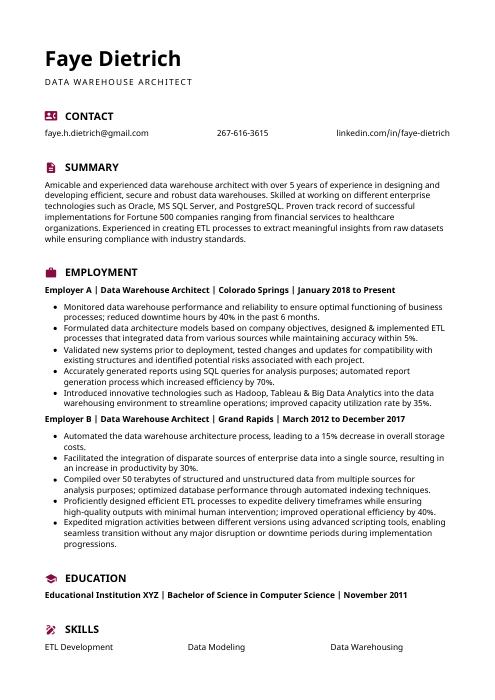 Hoopoe
Hoopoe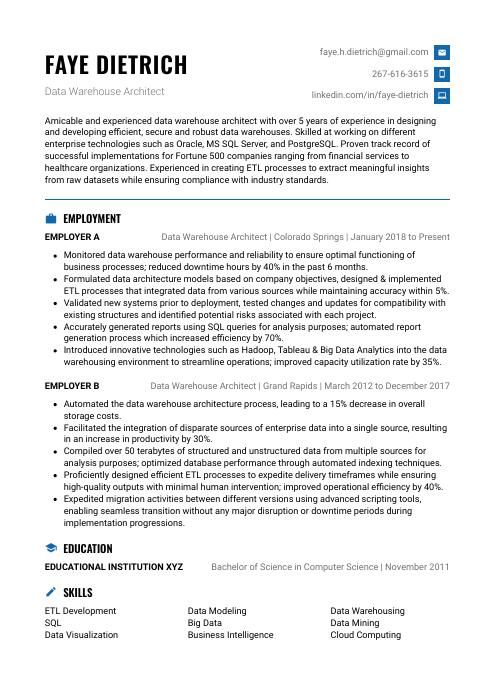 Echidna
Echidna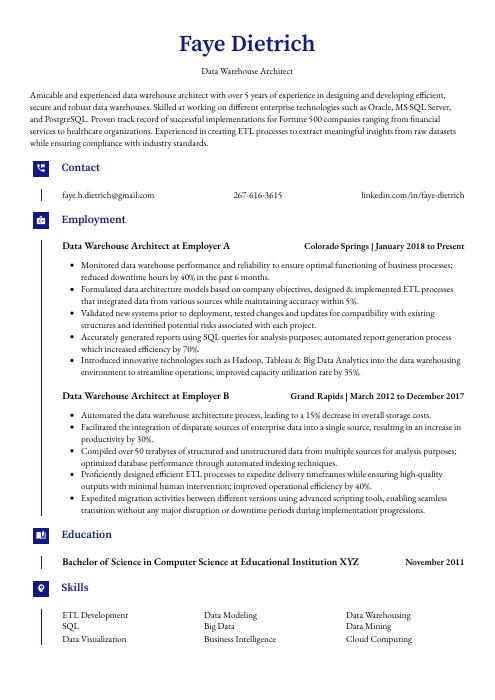 Gharial
Gharial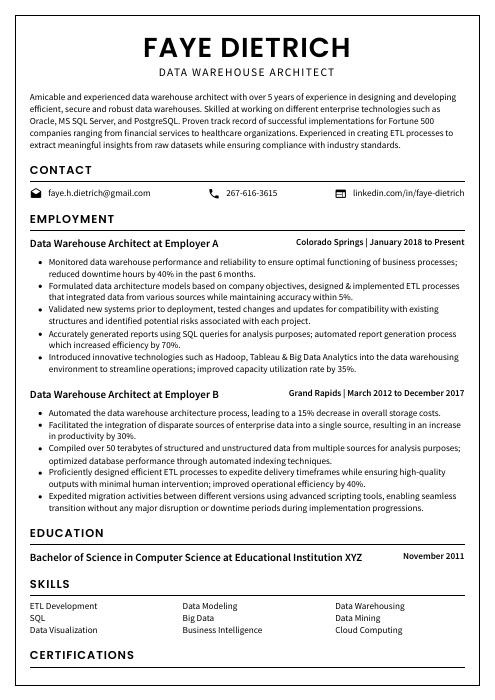 Cormorant
Cormorant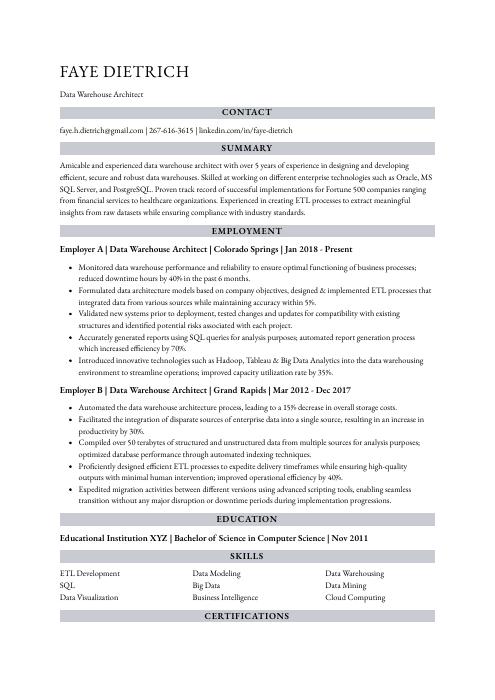 Numbat
Numbat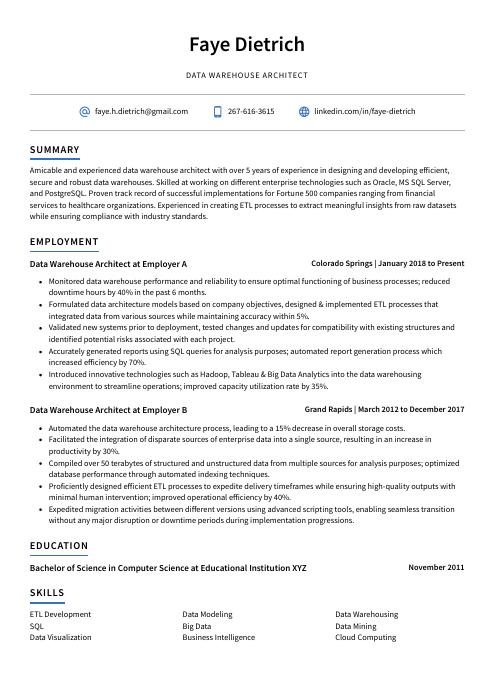 Axolotl
Axolotl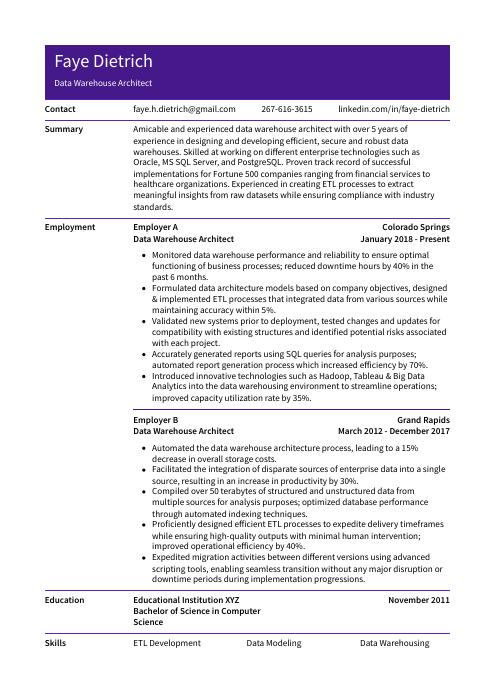 Pika
Pika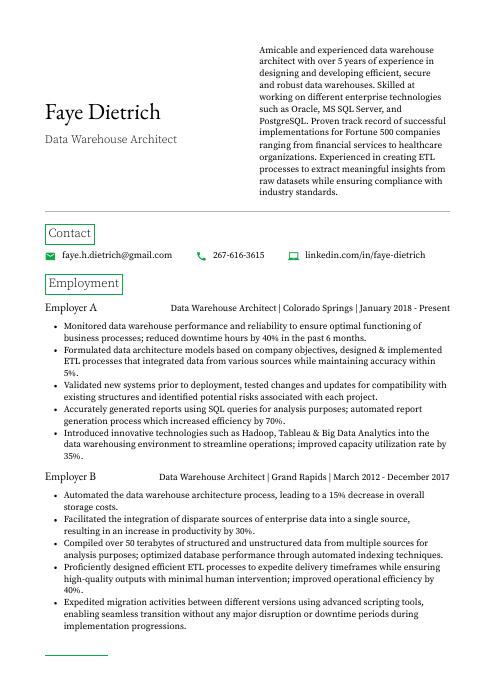 Quokka
Quokka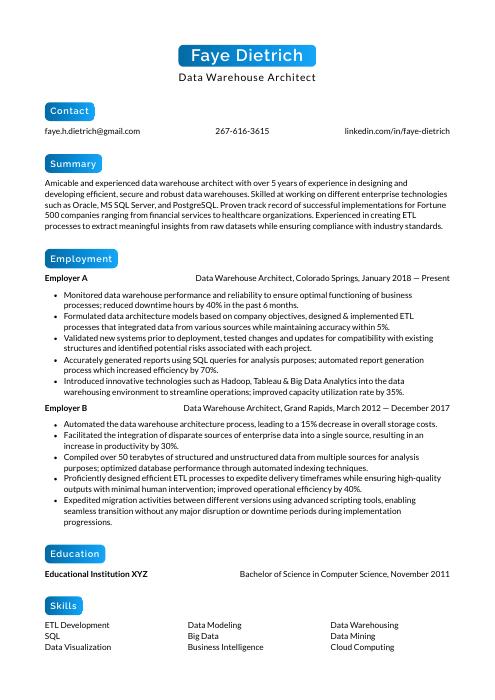 Kinkajou
Kinkajou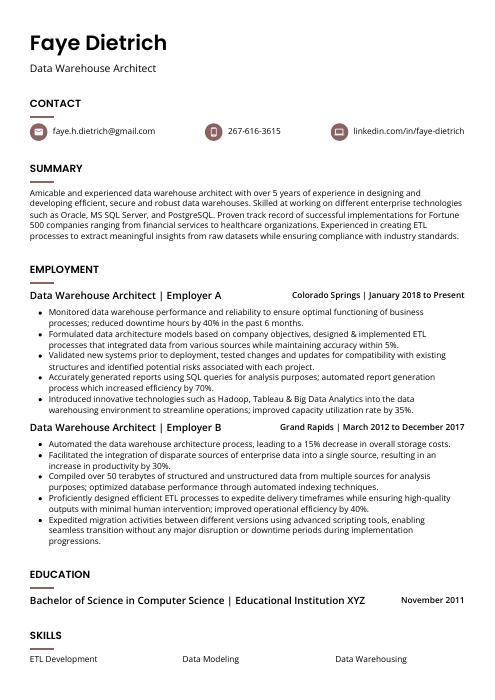 Fossa
Fossa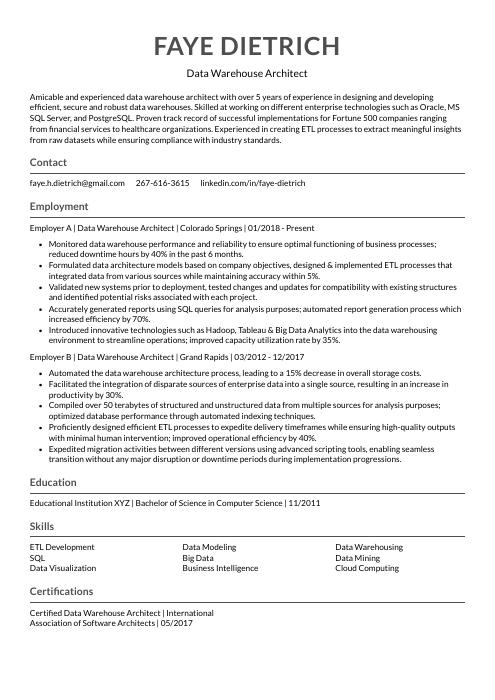 Indri
Indri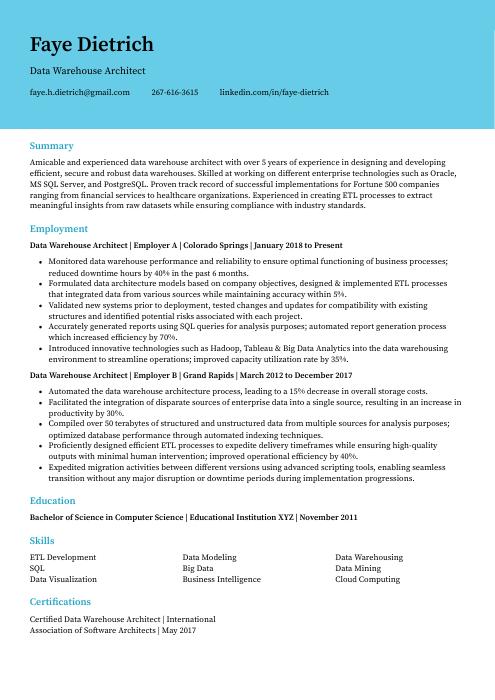 Dugong
Dugong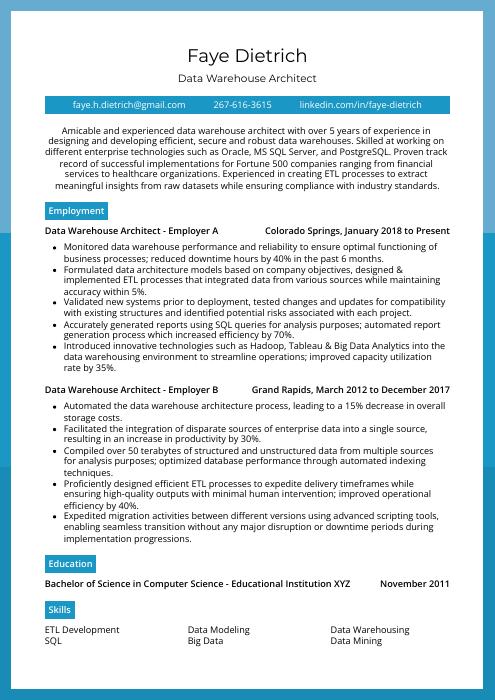 Rhea
Rhea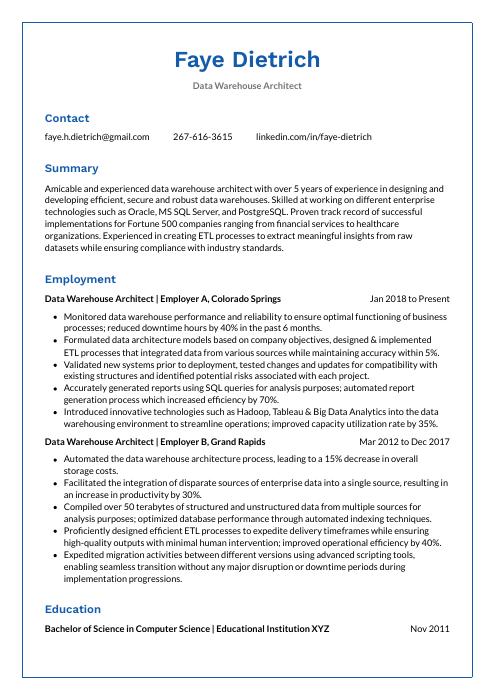 Markhor
Markhor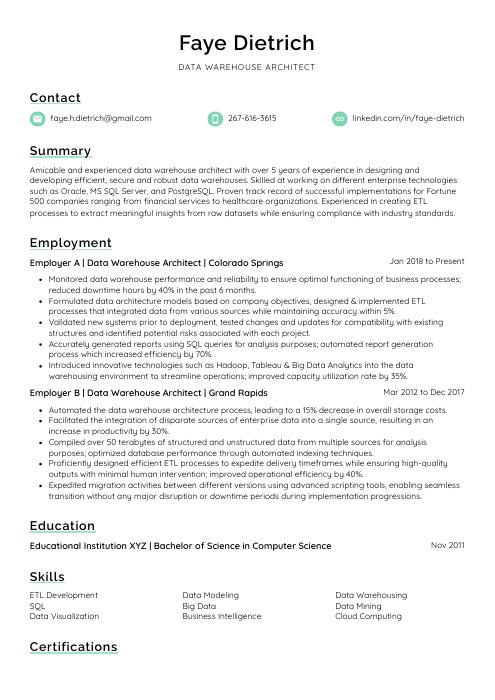 Lorikeet
Lorikeet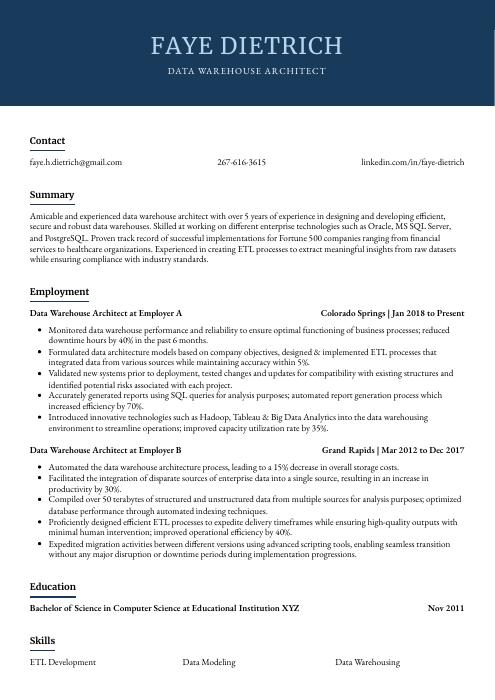 Bonobo
Bonobo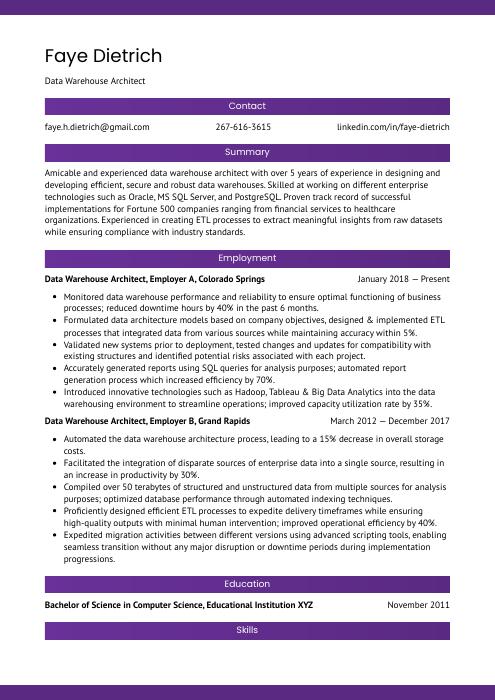 Jerboa
Jerboa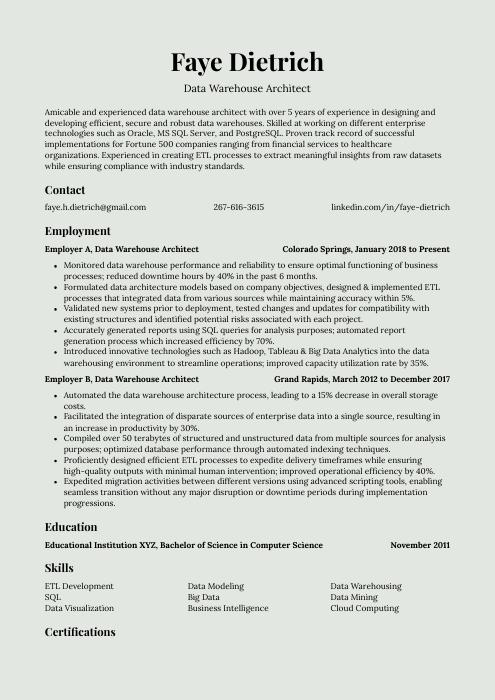 Saola
Saola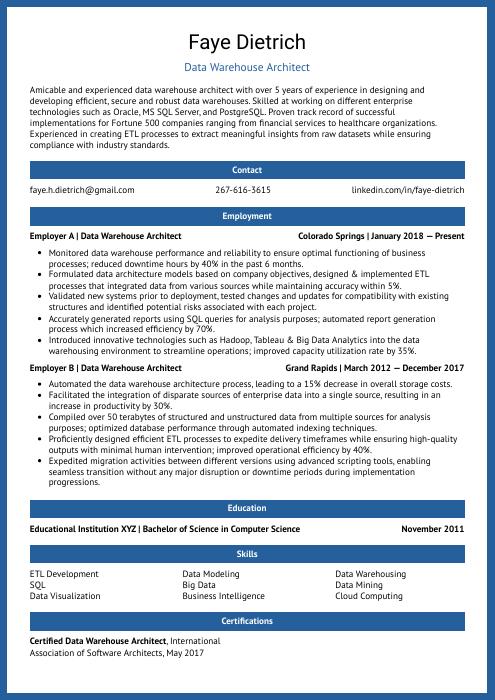 Ocelot
Ocelot Rezjumei
Rezjumei
